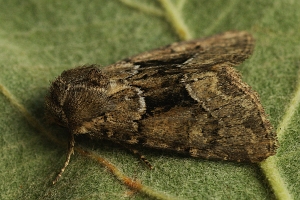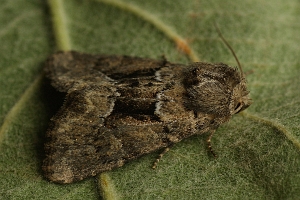

 +10Kontinente:EUAS
+10Kontinente:EUAS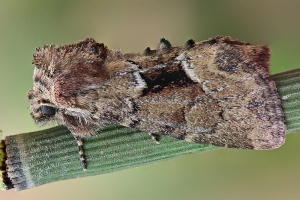
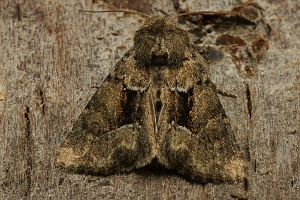
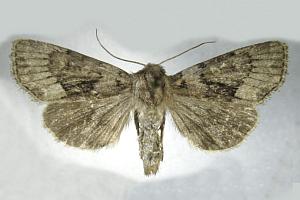
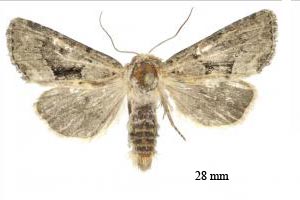
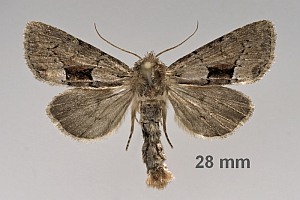
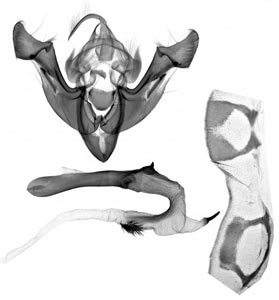
1. Lebendfotos
1.1. Falter
1.1.1. ssp. strix
1.1.2. ssp. retinax
1.1.3. ssp. stangelmaieri
2. Diagnose
2.1. Männchen
2.1.1. ssp. strix
2.1.2. ssp. retinax
2.1.3. ssp. stangelmaieri
2.2. Genitalien
2.2.1. Männchen (ssp. retinax)
3. Biologie
3.1. Nahrung der Raupe
- [Equisetaceae:] Equisetum hyemale (Winter-Schachtelhalm)
- [Equisetaceae:] Equisetum sp. (Schachtelhalm)
Nachdem klar war, dass sich Xylomoia strix im Baltikum als Raupe in Stängeln von Equisetum hyemale entwickelt, suchten Haverinen et al. (2024) auch gezielt nach den Raupen der beiden anderen Taxa retinax und stangelmaieri. Bei retinax hatten sie bei Nowosibirsk in Russland erstaunlichen Erfolg - es wurden gleich mehr als 1000 Raupen in Stängeln von Equisetum hyemale eingesammelt - und das an einem Ort, an dem vorher erst 7 Falter der Art bekannt waren. Die Raupen bevorzugten ganz klar dicke Stängel. Bei stangelmaieri in Nord-Italien verlief die Suche etwas komplizierter, aber auch hier war die Raupensuche in Equisetum schließlich erfolgreich. Die Autoren nannten nur keinen definitiven Artnamen: "RH visited it for the first time in 2007 and subsequently in 2009, when knowledge about the host plant of X. strix was shared with G. Stangelmaier and some plants of Equisetum damaged by X. stangelmaieri were found. [...] In March–April 2014, RH together with M. Hirvonen found a large number of caterpillars in stems of Equisetum plants near Venice: most of them had been collected in a pine forest, while some had been found on dry sand dunes. In the first half of December 2014, RH and AP collected numerous plants with caterpillars and handed them to K. Silvonen and T. Nupponen for breeding. The area was visited again by RH in 2015 and K. Nupponen in 2016. At the end of March 2024 RH, AP, and I. Jürjendal went again to collect Equisetum plants to identify the species to which they belonged. They grow up to 150 cm long, may branch, and have thin stems so that caterpillar stretch up to 3–4 cm to fit into them. Plants appeared to be neither Equisetum ramosissimus nor E. hyemale, but, probably, a hybrid or even triploid. Caterpillars of X. stangelmaieri deliberately chose E. hyemale over another species when offered them in laboratory conditions. They hibernated from mid-November to mid-March in the middle part of the stem in contrary to X. strix that overwintered in the lower part of the stems under snow cover." Der stabilisierte Bastard zwischen den beiden genannten Schachtelhalm-Arten, Equisetum xmoorei, ist weit verbreitet und tritt mitunter durchaus bestandsbildend auf - er ist auch aus Nord-Italien bekannt, kommt hier also sicher in Frage, nur die Wuchshöhe von 150 cm wäre sehr ungewöhnlich für dieses Taxon, von daher kommen auch weitere stabilisierte Hybride unter Beteilugung von Equisetum hyemale (und E. ramosissimum) in Frage.
(Autor: Erwin Rennwald)
4. Weitere Informationen
4.1. Etymologie (Namenserklärung)
ssp. strix: Mikkola (1980: 221): “The proposed name strix means owl, and comes from the downy, brown appearance of the moth.”
ssp. retinax: Mikkola (1998: 181): “Latin retinax meaning hiding, so named because the general distribution of the species in unknown.”
ssp. stangelmaieri: Mikkola (1998: 182): “Named in honour of the collection, Mr Günter Stangelmaier, Ing. (Villach, Austria).”
4.2. Typenmaterial
ssp. strix: Mikkola (1980: 221): “Material examined. Holotype ♂: Latvia, Turaida 1977-07-05, A. Šulcs leg. (in Zoological Museum, University of Helsinki). 1 ♀ (not closely examined): Southern Finland, U: Tvärminne (UTM: Nr.) 1974-07 H. Holmberg, I. Kontuniemi, A. Wennström & J. Wettenhovi leg.”
ssp. retinax: Mikkola (1998: 181): “Holotype: ♂, RUSSIA, Novosibirsk oblast', Akademgorodok, Pinus–Betula forest, 1.VII.1984, K. Mikkola & M. Viitassari leg (ZMHF). Paratypes: 4 ♂ and 2 ♀, same data, 29.VI.1984 (ZMHF, one in each of ZMAS, ZMUM and Coll. Sulcs, Riga); 1 ♂ S-Ural, Chelyabinsk District, Miass 20 km N, Miasovo Lake, 28.VI.1997, J. Junnilainen & K. Nupponen (Coll. Junnilainen).”
ssp. stangelmaieri: Mikkola (1998: 182): “Holotype: ♂, ITALY, I./Veneto, Caorle 9.VI.1995 Stangelmaier (ZMHF). Paratypes: 20 ♂ and 1 ♀, 5 ♂ and 1 ♀ with the same data as holotype; 1 ♂ the same place 21.V.1990; 14 ♂ the same place 9.VI.1996 (all G. Stangelmaier leg) (Coll. Stangelmaier and ZMHF).”
4.3. Taxonomie und Faunistik
Die Nominat-Unterart wurde in allen drei baltischen Staaten gefunden, westwärts bis Polen, südwärts bis Belarus, nordwärts bis Finnland und ostwärts bis etwa an den Ural in Russland. Der Typenfundort von ssp. retinaxliegt in Westsibirien (Region Novosibirsk); Zilli et al. (2005) konnten aus Europa nur über den Fund eines einzelnen Weibchens in Russland berichten. Pekarsky & Korb (2012) ergänzen "The first finding of Xylomoia retinax Mikkola, 1998 in Lover Volga region". Ob es zwischen diesen beiden Unterarten tatsächlich eine geographische Grenze gibt, ist noch unklar. Die beiden Taxa wurden zunächst als getrennte Arten beschrieben, nach den umfangreichen Untersuchungen von Haverinen et al. (2024) ist aber klar, dass sie im Barcode identisch sind und dass die in der Erstbeschreibung von X. retinax angeführten Unterschiede in den Genitalien so nicht existieren (starke Variabilität in beiden Taxa und dadurch fließende Übergänge). Auch die Lebensweise der Raupen ist völlig identisch, so dass kein Weg an der Herabstufung des Taxons zur Unterart von X. strix vorbeiführt.
Auch das Taxon stangelmaieri wurde zunächst als eigene Art beschrieben. Das Taxon ist vom Typenfundort in Norditalien bekannt, wurde dort aber immer wieder gefunden (Zilli et al. (2005), Haverinen et al. (2024)). Wie für stark isolierte Vorposten nicht unüblich, gibt es beim Barcode eine Abweichung von fast 2 % (1,84 %) gegenüber den beiden anderen Taxa. Man könnte hier diskutieren, den Artstatus doch beizubehalten, fehlende klare Unterschiede in der (Genital-)Morphologie (wegen starker individueller Variabilität innerhalb aller 3 Unterarten !) sprechen aber doch für die von Haverinen et al. (2024) gewählte Einordnung als Unterart von X. strix.
(Autor: Erwin Rennwald)
4.4. Literatur
- Haverinen, R., Pototski, A., Mutanen, M., Mikalauskas, D., Yakovlev, R.V., Müller, G.C., Prozorov, A.M. & A. Saldaitis (2024): Integrative review of Xylomoia strix, X. retinax and X. stangelmaieri (Lepidoptera, Noctuidae, Xyleninae, Apameini). — Zookeys, 1221: 309–342. [zum open access-Artikel auf zookeys.pensoft.net]
- Erstbeschreibung: Mikkola, K. (1980): Two new noctuid species from Northern Europe: Polia sabmeana n. sp. and Xylomoia strix n. sp. (Lepidoptera, Noctuidae: Hadeninae and Amphipyrinae). — Notulae Entomologicae 60 (4): 217-222.
- Beschreibung als Xylomoia retinax und Xylomoia stangelmaieri: Mikkola, K. (1998): Revision of the genus Xylomoia Staudinger (Lepidoptera: Noctuidae), with descriptions of two new species. — Systematic Entomology 23 (2): 173-186.
- Nowacki, J. & K. Pałka (2016): Xylomoia strix Mikkola, 1980 in Poland with comments on its biology and ecology (Lepidoptera: Noctuidae). — SHILAP Revista de Lepidopterología 44 (174): 271-279 [PDF auf redalyc.org].
- Пекарский, О. Н. & С. К. Корб (2012): Первая находка Xylomoia retinax Mikkola, 1998 в Нижнем Поволжье (Lepidoptera: Noctuidae) [Pekarsky, O. N. & S. K. Korb (2012): The first finding of Xylomoia retinax Mikkola, 1998 in Lover [sic] Volga region (Lepidoptera: Noctuidae]. — Эверсманния. Энтомологические исследования в России и соседних регионах [Eversmannia. Entomological research in Russia and adjacent regions] 31-32: 114. [PDF auf eversmannia.entomology.ru]
- Zilli, A., Ronkay, L. & M. Fibiger (2005): Noctuidae Europaeae. Volume 8. Apamaeini. — 323 S., Farbtafeln; Sorø (Entomological Press).










